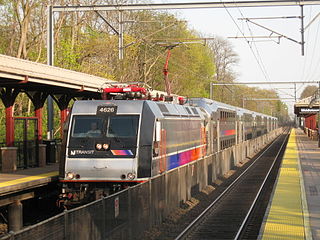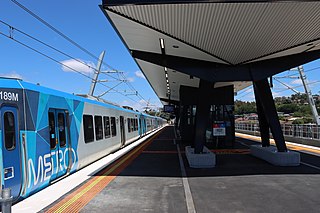
Commuter rail, or suburban rail, is a passenger rail transport service that primarily operates within a metropolitan area, connecting commuters to a central city from adjacent suburbs or commuter towns. Commuter rail systems are considered heavy rail, using electrified or diesel trains. Distance charges or zone pricing may be used.

Rail transport is a means of transport using wheeled vehicles running in tracks, which usually consist of two parallel steel rails. Rail transport is one of the two primary means of land transport, next to road transport. It is used for about 8% of passenger and freight transport globally, thanks to its energy efficiency and potentially high speed.

Network Rail Limited is the owner and infrastructure manager of most of the railway network in Great Britain. Network Rail is an "arm's length" public body of the Department for Transport with no shareholders, which reinvests its income in the railways.

ProRail is a Dutch government organisation responsible for the maintenance and extension of the national railway network infrastructure, the allocation of rail capacity, and controlling rail traffic. Prorail is a part of NS Railinfratrust, the Dutch railway infrastructure owner.

Railway signalling (BE), also called railroad signaling (AE), is a system used to control the movement of railway traffic. Trains move on fixed rails, making them uniquely susceptible to collision. This susceptibility is exacerbated by the enormous weight and inertia of a train, which makes it difficult to quickly stop when encountering an obstacle. In the UK, the Regulation of Railways Act 1889 introduced a series of requirements on matters such as the implementation of interlocked block signalling and other safety measures as a direct result of the Armagh rail disaster in that year.
Rail transport operations are the day-to-day operations of a railway. A railway has two major components: the infrastructure and the rolling stock

The Lilydale line is a commuter railway line in the city of Melbourne, Victoria, Australia. Operated by Metro Trains Melbourne, it is the city's sixth-longest metropolitan railway line at 37.8 kilometres (23.5 mi). The line runs from Flinders Street station in central Melbourne to Lilydale station in the east, serving 27 stations via Burnley, Box Hill, Ringwood, and Croydon. The line operates for approximately 19 hours a day with 24 hour service available on Friday and Saturday nights. During peak hours, headways of up to 15 minutes are operated, with services every 20–30 minutes during off-peak hours. Trains on the Lilydale line run in two three-car formations of X'Trapolis 100 trainsets.

The Belgrave line is a commuter railway line in the city of Melbourne, Victoria, Australia. Operated by Metro Trains Melbourne, it is the city's fourth-longest metropolitan railway line at 41.8 kilometres (26.0 mi). The line runs from Flinders Street station in central Melbourne to Belgrave station in the east, serving 31 stations via Burnley, Box Hill, Ringwood, and Upper Ferntree Gully. Beyond Belgrave, the narrow-gauge line has been restored as the Puffing Billy Railway, which runs tourist services to the original terminus of Gembrook. The line operates for approximately 19 hours a day with 24 hour service available on Friday and Saturday nights. During peak hours, headways of up to 15 minutes are operated, with services every 20–30 minutes during off-peak hours. Trains on the Belgrave line run in a two three-car formations of X'Trapolis 100 trainsets.
Various terms are used for passenger railway lines and equipment; the usage of these terms differs substantially between areas:

The Finnish railway network consists of a total track length of 9,216 km (5,727 mi). The railways are built with a broad 1,524 mm track gauge, of which 3,249 km (2,019 mi) is electrified. Passenger trains are operated by the state-owned enterprise VR that runs services on 7,225 km (4,489 mi) of track. These services cover all major cities and many rural areas, though the coverage is less than the coverage provided by the bus services. Most passenger train services originate or terminate at Helsinki Central railway station, and a large proportion of the passenger rail network radiates out of Helsinki. VR also operates freight services. Maintenance and construction of the railway network itself is the responsibility of the Finnish Rail Administration, which is a part of the Finnish Transport Agency. The network consists of six areal centres, that manage the use and maintenance of the routes in co-operation. Cargo yards and large stations may have their own signalling systems.

The rail transport system in Denmark consists of 2,633 km of railway lines, of which the Copenhagen S-train network, the main line Helsingør-Copenhagen-Padborg, and the Lunderskov-Esbjerg line are electrified. Most traffic is passenger trains, although there is considerable transit goods traffic between Sweden and Germany.

Rail transport in South Africa is an important element of the country's transport infrastructure. All major cities are connected by rail, and South Africa's railway system is the most highly developed in Africa. The South African rail industry is publicly owned.
Standards for North American railroad signaling in the United States are issued by the Association of American Railroads (AAR), which is a trade association of the railroads of Canada, the US, and Mexico. Their system is loosely based on practices developed in the United Kingdom during the early years of railway development. However, North American practice diverged from that of the United Kingdom due to different operating conditions and economic factors between the two regions. In Canada, the Canadian Rail Operating Rules (CROR) are approved by the Minister of Transport under the authority of the Railway Safety Act. Each railway company or transit authority in Canada issues its own CROR rulebook with special instructions peculiar to each individual property. Among the distinctions are:

Positive train control (PTC) is a family of automatic train protection systems deployed in the United States. Most of the United States' national rail network mileage has a form of PTC. These systems are generally designed to check that trains are moving safely and to stop them when they are not.

Rail transport in Greece has a history which began in 1869, with the completion of the then Athens & Piraeus Railway. From the 1880s to the 1920s, the majority of the network was built, reaching its heyday in 1940. From the 1950s onward, the railway system entered a period of decline, culminating in the service cuts of 2011. Ever since the 1990s, the network has been steadily modernized, but still remains smaller than its peak length. The operation of the Greek railway network is split between the Hellenic Railways Organisation (OSE), which owns and maintains the rail infrastructure; GAIAOSE, which owns the building infrastructure and the former OSE rolling stock, Hellenic Train; and other private companies that run the trains on the network. Greece is a member of the International Union of Railways (UIC). The UIC Country Code for Greece is 73.
The Single European Railway Directive 20122012/34/EU is an EU Directive that regulates railway networks in European Union law. This recast the "First Railway Directive" or "Package" from 1991, and allows open access operations on railway lines by companies other than those that own the rail infrastructure. The legislation was extended by further directives to include cross border transit of freight.

Communications-based train control (CBTC) is a railway signaling system that uses telecommunications between the train and track equipment for traffic management and infrastructure control. CBTC allows a train's position to be known more accurately than with traditional signaling systems. This makes railway traffic management safer and more efficient. Metros are able to reduce headways while maintaining or even improving safety.

Route capacity is the maximum number of vehicles, people, or amount of freight than can travel a given route in a given amount of time, usually an hour. It may be limited by the worst bottleneck in the system, such as a stretch of road with fewer lanes. Air traffic route capacity is affected by weather. For a metro or a light rail system, route capacity is generally the capacity of each vehicle, times the number of vehicles per train, times the number of trains per hour (tph). In this way, route capacity is highly dependent on headway. Beyond this mathematical theory, capacity may be influenced by other factors such as slow zones, single-tracked areas, and infrastructure limitations, e.g. to useful train lengths.

The Union Station Rail Corridor (USRC) is a corridor of railway tracks that exist through and adjacent to Union Station in downtown Toronto. It is 6.4 kilometres long, approximately stretching from Bathurst Street in the west to the Don River in the east, making it the largest rail passenger facility in Canada.

TCDD Transport is a government-owned railway company responsible for the operations of most passenger and freight rail in Turkey. The company was formed on 14 June 2016, splitting off from the Turkish State Railways (TCDD) to take over railway operations, while TCDD would continue to administer railway infrastructure. TCDD Taşımacılık officially began operations on 1 January 2017.
















